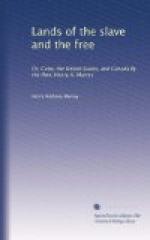Here we are in the “Queen City of the West,” the rapid rise whereof is astounding. By a statistical work, I find that in 1800 it numbered only 750 inhabitants; in 1840, 46,338—1850, 115,438: these calculations merely include its corporate limits. If the suburbs be added, the population will reach 150,000: of which number only about 3000 are coloured. The Americans constitute 54 per cent.; Germans, 28; English, 16; other foreigners, 2 per cent. of the population. They have 102 schools, and 357 teachers, and 20,737 pupils are yearly instructed by these means. Of these schools 19 are free, instructing 12,240 pupils, not in mere writing and reading, but rising in the scale to “algebra, grammar, history, composition, declamation, music, drawing,” &c. The annual cost of these schools is between 13,000l. and 14,000l. There is also a “Central School,” where the higher branches of literature and science are taught to those who have time and talent; in short, a “Free College.”
According to the ordinance for the North-Western territory of 1787, “religion, morality, and knowledge being necessary to good government and the happiness of mankind, schools and the means of education shall for ever be encouraged.” Congress, in pursuance of this laudable object, “has reserved one thirty-sixth part of all public lands for the support of education in the States in which the lands lie; besides which, it has added endowments for numerous universities, &c.” We have seen that the public schools in this city cost 13,500l., of which sum they receive from the State fund above alluded to 1500l., the remainder being raised by a direct tax upon the property of the city, and increased from time to time in proportion to the wants of the schools. One of the schools is for coloured children, and contains 360 pupils. There are 91 churches and 4 synagogues, and the population is thus classed—Jews, 3 per cent.; Roman Catholics, 35; Protestant, 62. The Press is represented by 12 daily and 20 weekly papers. From these statistics, dry though they may appear, one must confess that the means of education and religious instruction are provided for in a manner that reflects the highest credit on this “Queen City of the West.”
It is chiefly owing to the untiring perseverance of Mr. Longworth, that they have partially succeeded in producing wine. As far as I could ascertain, they made about fifty thousand gallons a year. The wine is called “Catawba,” from the grape, and is made both still and sparkling. Thanks to the kind hospitality of a friend, I was enabled to taste the best of each. I found the still wine rather thin and tart, but, as the weather was very cold, that need not affect the truth of my friend’s assertion, that in summer it was a very pleasant beverage. The sparkling wine was much more palatable, and reminded me of a very superior kind of perry. They cannot afford to sell it on the spot under four shillings a bottle, and of course the hotels double that price immediately. I think there can be no doubt that a decided improvement must be made in it before it can become valuable enough to find its way into the European market; although I must confess that, as it is, I should be most happy to see it supplant the poisonous liquids called champagne which appear at our “suppers,” and at many of our hotels.




